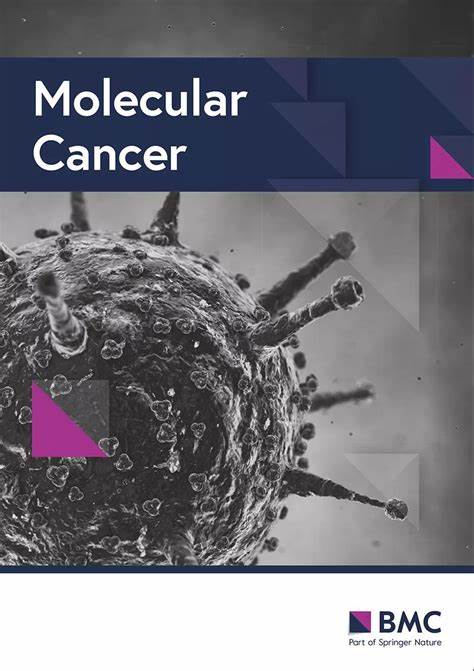Spatial transcriptomic analysis of tumor microenvironment in esophageal squamous cell carcinoma with HIV infection
IF 27.7
1区 医学
Q1 BIOCHEMISTRY & MOLECULAR BIOLOGY
引用次数: 0
Abstract
Human Immunodeficiency Virus (HIV) is one of the most prevalent viruses, causing significant immune depletion in affected individuals. Current treatments can control HIV and prolong patients’ lives, but new challenges have emerged. Increasing incidence of cancers occur in HIV patients. Esophageal squamous cell carcinoma (ESCC) is one of the most common cancers observed in HIV patients. However, the spatial cellular characteristics of HIV-related ESCC have not been explored, and the differences between HIV-ESCC and typical ESCC remain unclear. We performed spatial transcriptome sequencing on HIV-ESCC samples to depict the microenvironment and employed cell communication analysis and multiplex immunofluorescence to investigate the molecular mechanism in HIV-ESCC. We found that HIV-ESCC exhibited a unique cellular composition, with fibroblasts and epithelial cells intermixed throughout the tumor tissue, lacking obvious spatial separation, while other cell types were sparse. Besides, HIV-ESCC exhibited an immune desert phenotype, characterized by a low degree of immune cell infiltration, with only a few SPP1+ macrophages showing immune resistance functions. Cell communication analysis and multiplex immunofluorescence staining revealed that tumor fibroblasts in HIV-ESCC interact with CD44+ epithelial cells via COL1A2, promoting the expression of PIK3R1 in epithelial cells. This interaction activates the PI3K-AKT signaling pathway, which contributes to the progression of HIV-ESCC. Our findings depict the spatial microenvironment of HIV-ESCC and elucidate a molecular mechanism in the progression of HIV-ESCC. This will provide us insights into the molecular basis of HIV-ESCC and potential treatment strategies.伴HIV感染的食管鳞状细胞癌肿瘤微环境的空间转录组学分析
人类免疫缺陷病毒(HIV)是最流行的病毒之一,在受感染的个体中引起显著的免疫衰竭。目前的治疗方法可以控制艾滋病毒并延长患者的生命,但新的挑战已经出现。艾滋病毒患者的癌症发病率不断上升。食管鳞状细胞癌(ESCC)是HIV患者中最常见的癌症之一。然而,hiv相关ESCC的空间细胞特征尚未被探索,HIV-ESCC与典型ESCC之间的差异尚不清楚。我们对HIV-ESCC样本进行了空间转录组测序来描述微环境,并利用细胞通讯分析和多重免疫荧光来研究HIV-ESCC的分子机制。我们发现HIV-ESCC表现出独特的细胞组成,成纤维细胞和上皮细胞在整个肿瘤组织中混杂,缺乏明显的空间分离,而其他细胞类型则稀疏。此外,HIV-ESCC表现出免疫沙漠表型,其特征是免疫细胞浸润程度低,只有少数SPP1+巨噬细胞具有免疫抵抗功能。细胞通讯分析和多重免疫荧光染色显示,HIV-ESCC的肿瘤成纤维细胞通过COL1A2与CD44+上皮细胞相互作用,促进上皮细胞中PIK3R1的表达。这种相互作用激活PI3K-AKT信号通路,促进HIV-ESCC的进展。我们的研究结果描述了HIV-ESCC的空间微环境,并阐明了HIV-ESCC进展的分子机制。这将使我们深入了解HIV-ESCC的分子基础和潜在的治疗策略。
本文章由计算机程序翻译,如有差异,请以英文原文为准。
求助全文
约1分钟内获得全文
求助全文
来源期刊

Molecular Cancer
医学-生化与分子生物学
CiteScore
54.90
自引率
2.70%
发文量
224
审稿时长
2 months
期刊介绍:
Molecular Cancer is a platform that encourages the exchange of ideas and discoveries in the field of cancer research, particularly focusing on the molecular aspects. Our goal is to facilitate discussions and provide insights into various areas of cancer and related biomedical science. We welcome articles from basic, translational, and clinical research that contribute to the advancement of understanding, prevention, diagnosis, and treatment of cancer.
The scope of topics covered in Molecular Cancer is diverse and inclusive. These include, but are not limited to, cell and tumor biology, angiogenesis, utilizing animal models, understanding metastasis, exploring cancer antigens and the immune response, investigating cellular signaling and molecular biology, examining epidemiology, genetic and molecular profiling of cancer, identifying molecular targets, studying cancer stem cells, exploring DNA damage and repair mechanisms, analyzing cell cycle regulation, investigating apoptosis, exploring molecular virology, and evaluating vaccine and antibody-based cancer therapies.
Molecular Cancer serves as an important platform for sharing exciting discoveries in cancer-related research. It offers an unparalleled opportunity to communicate information to both specialists and the general public. The online presence of Molecular Cancer enables immediate publication of accepted articles and facilitates the presentation of large datasets and supplementary information. This ensures that new research is efficiently and rapidly disseminated to the scientific community.
 求助内容:
求助内容: 应助结果提醒方式:
应助结果提醒方式:


